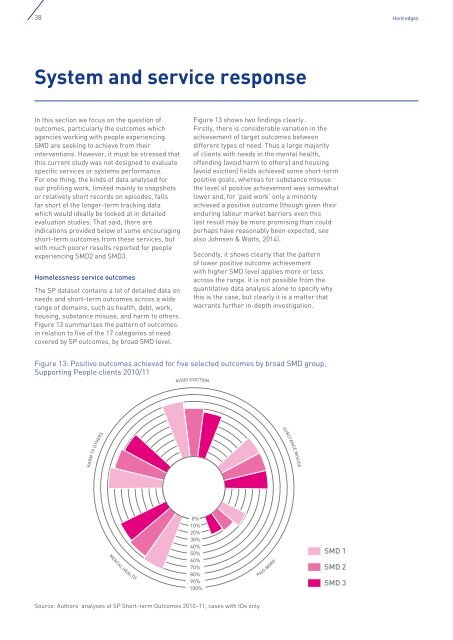Hard_Edges_Mapping_SMD_FINAL_VERSION_Web
Hard_Edges_Mapping_SMD_FINAL_VERSION_Web
Hard_Edges_Mapping_SMD_FINAL_VERSION_Web
You also want an ePaper? Increase the reach of your titles
YUMPU automatically turns print PDFs into web optimized ePapers that Google loves.
38 <strong>Hard</strong> edges<br />
System and service response<br />
In this section we focus on the question of<br />
outcomes, particularly the outcomes which<br />
agencies working with people experiencing<br />
<strong>SMD</strong> are seeking to achieve from their<br />
interventions. However, it must be stressed that<br />
this current study was not designed to evaluate<br />
specific services or systems performance.<br />
For one thing, the kinds of data analysed for<br />
our profiling work, limited mainly to snapshots<br />
or relatively short records on episodes, falls<br />
far short of the longer-term tracking data<br />
which would ideally be looked at in detailed<br />
evaluation studies. That said, there are<br />
indications provided below of some encouraging<br />
short‐term outcomes from these services, but<br />
with much poorer results reported for people<br />
experiencing <strong>SMD</strong>2 and <strong>SMD</strong>3.<br />
utcomes achieved for five<br />
Figure 13 shows two findings clearly.<br />
Firstly, there is considerable variation in the<br />
achievement of target outcomes between<br />
different types of need. Thus a large majority<br />
of clients with needs in the mental health,<br />
offending (avoid harm to others) and housing<br />
(avoid eviction) fields achieved some short-term<br />
positive goals, whereas for substance misuse<br />
the level of positive achievement was somewhat<br />
lower and, for ‘paid work’ only a minority<br />
achieved a positive outcome (though given their<br />
enduring labour market barriers even this<br />
last result may be more promising than could<br />
perhaps have reasonably been expected, see<br />
also Johnsen & Watts, 2014).<br />
Secondly, it shows clearly that the pattern<br />
of lower positive outcome achievement<br />
with higher <strong>SMD</strong> level applies more or less<br />
outcomes Homelessness by service broad outcomes<strong>SMD</strong> group, across the range. It is not possible from the<br />
The SP dataset contains a lot of detailed data on quantitative data analysis alone to specify why<br />
g People<br />
needs and short-term<br />
clients<br />
outcomes<br />
2010/11<br />
across a wide this is the case, but clearly it is a matter that<br />
range of domains, such as health, debt, work, warrants further in-depth investigation.<br />
housing, substance misuse, and harm to others.<br />
Figure 13 summarises the pattern of outcomes<br />
in relation to five of the 17 categories of need<br />
covered by SP outcomes, by broad <strong>SMD</strong> level.<br />
Figure 13: Positive outcomes achieved for five selected outcomes by broad <strong>SMD</strong> group,<br />
Supporting People clients 2010/11<br />
AVOID EVICTION<br />
SUBSTANCE MISUSE<br />
HARM TO OTHERS<br />
MENTAL HEALTH<br />
0%<br />
10%<br />
20%<br />
30%<br />
40%<br />
50%<br />
60%<br />
70%<br />
80%<br />
90%<br />
100%<br />
PAID WORK<br />
<strong>SMD</strong> 1<br />
<strong>SMD</strong> 2<br />
<strong>SMD</strong> 3<br />
Source: Authors’ analyses of SP Short-term Outcomes 2010–11, cases with IDs only


